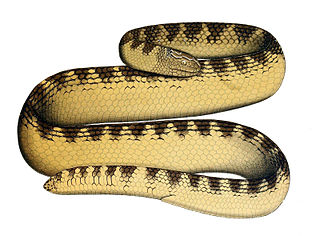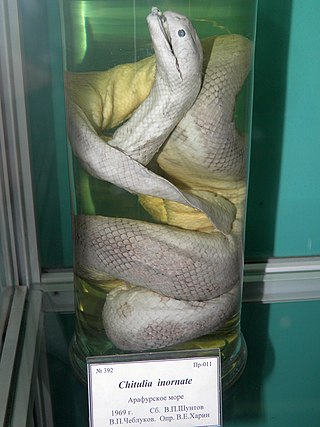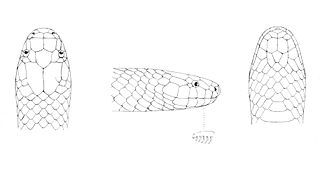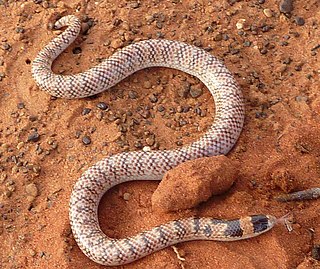
Hydrophiinae is a subfamily of venomous snakes in the family Elapidae. It contains most sea snakes and many genera of venomous land snakes found in Australasia, such as the taipans (Oxyuranus), tiger snakes (Notechis), brown snakes (Pseudonaja) and death adders (Acanthophis).

Acanthophis is a genus of elapid snakes. Commonly called death adders, they are native to Australia, New Guinea and nearby islands, and are among the most venomous snakes in the world. Despite their common name, they are not adders at all and belong to the Elapidae family. The name of the genus derives from the Ancient Greek akanthos/ἄκανθος ('spine') and ophis/ὄφις ('snake'), referring to the spine on the death adder's tail.

The eastern brown snake, often referred to as the common brown snake, is a species of extremely venomous snake in the family Elapidae. The species is native to eastern and central Australia and southern New Guinea. It was first described by André Marie Constant Duméril, Gabriel Bibron, and Auguste Duméril in 1854. The adult eastern brown snake has a slender build and can grow to 2 m (7 ft) in length. The colour of its surface ranges from pale brown to black, while its underside is pale cream-yellow, often with orange or grey splotches. The eastern brown snake is found in most habitats except dense forests, often in farmland and on the outskirts of urban areas, as such places are populated by its main prey, the house mouse. The species is oviparous. The International Union for Conservation of Nature classifies the snake as a least-concern species, though its status in New Guinea is unclear.

The red-bellied black snake is a species of venomous snake in the family Elapidae, indigenous to Australia. Originally described by George Shaw in 1794 as a species new to science, it is one of eastern Australia's most commonly encountered snakes. Averaging around 1.25 m in length, it has glossy black upperparts, bright red or orange flanks, and a pink or dull red belly. It is not aggressive and generally retreats from human encounters, but can attack if provoked. Although its venom can cause significant illness, no deaths have been recorded from its bite, which is less venomous than other Australian elapid snakes. The venom contains neurotoxins, myotoxins, and coagulants and has haemolytic properties. Victims can also lose their sense of smell.

The dugite is a species of venomous, potentially lethal snake native to Western Australia, a member of the family Elapidae.

The Barkly Tableland is a region in the Central East if the Northern Territory, extending into Western Queensland. The region was named after Sir Henry Barkly. The epithet “Tableland” is inaccurate, since the region is neither elevated relative to adjacent landforms, nor are the boundaries marked by a distinct change in elevation

Aipysurus eydouxii, commonly known as the beaded sea snake, the marbled seasnake, and the spine-tailed seasnake, is a species of venomous snake in the family Elapidae. A. eydouxii is unusual amongst sea snakes in that it feeds almost exclusively on fish eggs. As part of this unusual diet, this species has lost its fangs, and the venom glands are almost entirely atrophied.

Hydrophis inornatus, commonly known as the plain sea snake, is a species of venomous sea snake in the family Elapidae.

Pseudonaja is a genus of highly venomous elapid snakes native to Australia. Species of this genus are known commonly as brown snakes and are considered to be some of the most dangerous snakes in the world; even young snakes are capable of delivering a fatal envenomation to a human.

The king brown snake is a species of highly venomous snake of the family Elapidae, native to northern, western, and Central Australia. The king brown snake is the largest terrestrial venomous snake in Australia. Despite its common name, it is a member of the genus Pseudechis and only distantly related to true brown snakes. Its alternative common name is the mulga snake, although it lives in many habitats apart from mulga. First described by English zoologist John Edward Gray in 1842, it is a robust snake up to 3.3 m (11 ft) long. It is variable in appearance, with individuals from northern Australia having tan upper parts, while those from southern Australia are dark brown to blackish. Sometimes, it is seen in a reddish-green texture. The dorsal scales are two-toned, sometimes giving the snake a patterned appearance. Its underside is cream or white, often with orange splotches. The species is oviparous. The snake is considered to be a least-concern species according to the International Union for Conservation of Nature, though may have declined with the spread of the cane toad.

The yellow-faced whip snake is a species of venomous snake in the family Elapidae, a family containing many dangerous snakes. D. psammophis is endemic to Australia, found throughout the continent in a variety of habitats from coastal fringes to interior arid scrubland.

The highland copperhead, also known as Ramsay's copperhead, is a species of venomous snake in the family Elapidae endemic to Australia.

Toxicocalamus is a genus of snakes in the family Elapidae. The genus is endemic to New Guinea.

The red-naped snake is a small venomous reptile from the family Elapidae. The snakes are found in four Australian states and are listed as 'threatened' in Victoria'. They are nocturnal and feed on small skinks. The young eastern brown snake is similar in appearance.

The western brown snake is commonly known as Mengden's brown snake, and alternatively, gwardar.

The ringed brown snake is a species of venomous elapid snake native to a broad swathe of inland Australia, from western New South Wales and Queensland to Western Australia.

The speckled brown snake or spotted brown snake is a species of venomous elapid snake native to northeastern Australia.

The strap-snouted brown snake is a species of venomous snake in the family Elapidae. The species is native to South Australia, New South Wales, Queensland, and Victoria. P. aspidorhyncha is part of a species complex that also includes P. mengdeni and P. nuchalis; all were formerly included in the latter species.

Brachyurophis fasciolatus is a species of snake from the family Elapidae, commonly named the narrow-banded shovel-nosed snake, or narrow-banded burrowing snake, and is a species endemic to Australia. Its common names reflect its shovel nose specialization, burrowing behaviour and banded body colour.

The Mallee black-backed snake also known as the Mitchell's short-tailed snake or more commonly as the black-backed snake, is a species of venomous snake from the family Elapidae. This species is native to Australia and is found in a variety of habitats in southern mainland Australia.


















